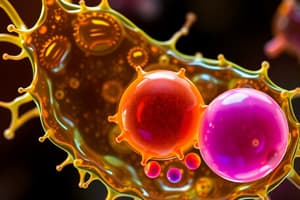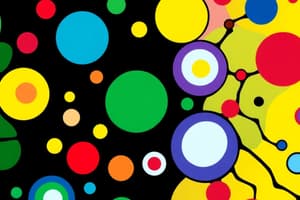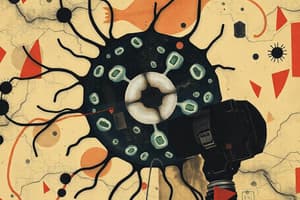Podcast
Questions and Answers
If cellular respiration were to be completely inhibited within a cell, which of the following processes would be most immediately affected?
If cellular respiration were to be completely inhibited within a cell, which of the following processes would be most immediately affected?
- The replication of DNA during cell division
- The synthesis of glucose from carbon dioxide and water
- The transport of molecules across the cell membrane
- The production of ATP to power cellular activities (correct)
The law of independent assortment states that alleles of different genes always assort together during gamete formation if situated on the same chromosome.
The law of independent assortment states that alleles of different genes always assort together during gamete formation if situated on the same chromosome.
False (B)
Describe how the central dogma of molecular biology explains the flow of genetic information within a biological system. What are the key steps and molecules involved?
Describe how the central dogma of molecular biology explains the flow of genetic information within a biological system. What are the key steps and molecules involved?
The central dogma describes the flow of genetic information from DNA to RNA to protein. First, DNA is transcribed into RNA, particularly mRNA. Then, mRNA is translated into protein, which carries out various functions in the cell.
In eukaryotic cells, the process of ______ involves the synthesis of RNA from a DNA template and occurs in the nucleus.
In eukaryotic cells, the process of ______ involves the synthesis of RNA from a DNA template and occurs in the nucleus.
Match each evolutionary mechanism with its primary effect on genetic variation within a population:
Match each evolutionary mechanism with its primary effect on genetic variation within a population:
Which of the following adaptations would be most beneficial for plants living in a hot, arid environment?
Which of the following adaptations would be most beneficial for plants living in a hot, arid environment?
Anabolic pathways release energy by breaking down complex molecules into simpler compounds.
Anabolic pathways release energy by breaking down complex molecules into simpler compounds.
Describe the role of the Golgi apparatus in processing and packaging proteins synthesized in the endoplasmic reticulum. What are the main steps involved?
Describe the role of the Golgi apparatus in processing and packaging proteins synthesized in the endoplasmic reticulum. What are the main steps involved?
The process by which plants convert light energy into chemical energy, using carbon dioxide and water to produce glucose and oxygen, is known as ______.
The process by which plants convert light energy into chemical energy, using carbon dioxide and water to produce glucose and oxygen, is known as ______.
Match each phase of the cell cycle with its primary activity:
Match each phase of the cell cycle with its primary activity:
Which of the following is the most accurate description of the role of tRNA in translation?
Which of the following is the most accurate description of the role of tRNA in translation?
All mutations are harmful and lead to a decrease in an organism's fitness.
All mutations are harmful and lead to a decrease in an organism's fitness.
Explain the concept of allopatric speciation and describe the conditions under which it is most likely to occur.
Explain the concept of allopatric speciation and describe the conditions under which it is most likely to occur.
The enzyme responsible for unwinding and separating the DNA strands during replication is called ______.
The enzyme responsible for unwinding and separating the DNA strands during replication is called ______.
Match each component of an ecosystem with its primary role:
Match each component of an ecosystem with its primary role:
Which of the following best describes the role of lysosomes within a cell?
Which of the following best describes the role of lysosomes within a cell?
In Mendelian genetics, a recessive allele is expressed in the phenotype only when one copy of it is present in the genotype.
In Mendelian genetics, a recessive allele is expressed in the phenotype only when one copy of it is present in the genotype.
Explain the key differences between prokaryotic and eukaryotic cells, with specific reference to their structural components and complexity.
Explain the key differences between prokaryotic and eukaryotic cells, with specific reference to their structural components and complexity.
The process of copying DNA, which occurs during cell division and results in two identical DNA molecules, is called ______.
The process of copying DNA, which occurs during cell division and results in two identical DNA molecules, is called ______.
Match each type of RNA with its primary function in gene expression:
Match each type of RNA with its primary function in gene expression:
Flashcards
What is Biology?
What is Biology?
The scientific study of life, exploring structure, function, growth, origin, evolution, and distribution of living organisms.
Cell Theory
Cell Theory
All living organisms are composed of cells.
Gene Theory
Gene Theory
Hereditary information is encoded in DNA and passed from parents to offspring.
Evolution
Evolution
Signup and view all the flashcards
Atoms
Atoms
Signup and view all the flashcards
Molecules
Molecules
Signup and view all the flashcards
Organelles
Organelles
Signup and view all the flashcards
Cells
Cells
Signup and view all the flashcards
Tissues
Tissues
Signup and view all the flashcards
Organs
Organs
Signup and view all the flashcards
Organ Systems
Organ Systems
Signup and view all the flashcards
Organisms
Organisms
Signup and view all the flashcards
Populations
Populations
Signup and view all the flashcards
Communities
Communities
Signup and view all the flashcards
Ecosystems
Ecosystems
Signup and view all the flashcards
Biosphere
Biosphere
Signup and view all the flashcards
Central Dogma of Molecular Biology
Central Dogma of Molecular Biology
Signup and view all the flashcards
Cell theory
Cell theory
Signup and view all the flashcards
Prokaryotic Cells
Prokaryotic Cells
Signup and view all the flashcards
Eukaryotic Cells
Eukaryotic Cells
Signup and view all the flashcards
Study Notes
- Biology is the scientific study of life
- Explores the structure, function, growth, origin, evolution, and distribution of living organisms
Core Principles of Biology
- All living organisms are composed of cells, according to cell theory
- Hereditary information is encoded in DNA and passed from parents to offspring according to gene theory
- Evolution explains the unity and diversity of life
Levels of Biological Organization
- Atoms are the basic units of matter
- Molecules are two or more atoms held together by chemical bonds
- Organelles are structures within cells that perform specific functions
- Cells are the basic units of life
- Tissues are groups of similar cells performing a specific function
- Organs are structures composed of different tissues working together
- Organ systems are groups of organs working together
- Organisms are individual living beings
- Populations are groups of individuals of the same species in a defined area
- Communities are populations of different species interacting with each other
- Ecosystems are communities plus the nonliving environment
- The biosphere is all ecosystems on Earth
Central Dogma of Molecular Biology
- Describes the flow of genetic information as DNA (Deoxyribonucleic acid) -> RNA (Ribonucleic acid) -> Protein
Cell Structure and Function
- Cells are the basic structural and functional units of life
- There are two main types of cells: prokaryotic and eukaryotic
Prokaryotic Cells
- Lack a nucleus
- DNA is located in the nucleoid region
- Generally smaller and simpler than eukaryotic cells
- Examples: bacteria and archaea
Eukaryotic Cells
- Have a nucleus containing DNA
- Possess membrane-bound organelles with specific functions
- Examples: animal cells, plant cells, fungi, and protists
Key Organelles in Eukaryotic Cells
- Nucleus: Contains DNA and controls cellular activities
- Endoplasmic reticulum (ER): Involved in protein and lipid synthesis
- Golgi apparatus: Modifies, sorts, and packages proteins and lipids
- Mitochondria: Site of cellular respiration, generates ATP
- Chloroplasts (in plant cells): Site of photosynthesis
- Lysosomes: Contain enzymes for breaking down cellular waste
Cell Membrane
- A selectively permeable barrier
- Composed of a phospholipid bilayer with embedded proteins
- Regulates the movement of substances into and out of the cell
Cell Communication
- Cells communicate through chemical signals via reception, transduction, and response stages
Metabolism
- The sum of all chemical reactions in an organism
- Anabolism: Building complex molecules from simpler ones, requiring energy
- Catabolism: Breaking down complex molecules into simpler ones, releasing energy
Enzymes
- Biological catalysts that speed up chemical reactions
- Highly specific to their substrates
- They are not consumed or changed in the reaction
Cellular Respiration
- Process that converts the energy stored in glucose into ATP
- Occurs in mitochondria
- Involves glycolysis, the Krebs cycle, and the electron transport chain
Photosynthesis
- Process by which plants and other organisms convert light energy into chemical energy
- Occurs in chloroplasts
- Uses carbon dioxide and water to produce glucose and oxygen
Genetics
- The study of heredity and variation
- Genes are the units of heredity
DNA Structure
- Double helix composed of nucleotides
- Nucleotides consist of a sugar, a phosphate group, and a nitrogenous base
- Four nitrogenous bases: adenine (A), guanine (G), cytosine (C), and thymine (T)
- A pairs with T, and C pairs with G
DNA Replication
- Process of copying DNA
- Occurs during cell division
- Results in two identical DNA molecules
RNA Structure
- Single-stranded
- Contains ribose sugar instead of deoxyribose
- Uracil (U) replaces thymine (T)
- Types of RNA: mRNA, tRNA, rRNA
Transcription
- Process of synthesizing RNA from a DNA template
- Occurs in the nucleus
- Produces mRNA
Translation
- Process of synthesizing a protein from an mRNA template
- Occurs in ribosomes
- Involves tRNA carrying amino acids to the ribosome
The Genetic Code
- Set of rules by which information encoded in genetic material (DNA or RNA) is translated into proteins
- Codons: Three-nucleotide sequences that specify particular amino acids
Mutations
- Changes in the DNA sequence
- Can be spontaneous or induced by mutagens
- Can be harmful, beneficial, or neutral
Gene Expression
- The process by which the information encoded in a gene is used to synthesize a functional gene product (protein or RNA)
- Can be regulated at various stages
Cell Cycle
- The series of events that take place in a cell leading to its division and duplication of its DNA
- Includes interphase, mitosis, and cytokinesis
Interphase
- Cell grows and prepares for division
- DNA replicates
- Consists of G1, S, and G2 phases
Mitosis
- Nuclear division
- Results in two identical daughter cells
- Includes prophase, metaphase, anaphase, and telophase
Cytokinesis
- Division of the cytoplasm
- Results in two separate daughter cells
Meiosis
- Cell division that produces gametes (sex cells)
- Results in four genetically different daughter cells
- Two rounds of division: meiosis I and meiosis II
Mendelian Genetics
- Gregor Mendel's laws of inheritance
Law of Segregation
- Each individual has two alleles for each gene, and these alleles separate during gamete formation
Law of Independent Assortment
- Alleles of different genes assort independently of one another during gamete formation
Genotype and Phenotype
- Genotype: The genetic makeup of an organism
- Phenotype: The observable characteristics of an organism
Alleles
- Different forms of a gene
- Dominant allele: Expressed when present
- Recessive allele: Only expressed when two copies are present
Evolution
- The change in the heritable characteristics of biological populations over successive generations
Natural Selection
- Individuals with advantageous traits are more likely to survive and reproduce
- Leads to adaptation
Evidence for Evolution
- Fossil record
- Comparative anatomy
- Embryology
- Molecular biology
- Biogeography
Mechanisms of Evolution
- Mutation
- Gene flow
- Genetic drift
- Natural selection
Speciation
- The process by which new species arise
- Allopatric speciation: Geographic isolation
- Sympatric speciation: Reproductive isolation within the same geographic area
Ecology
- The study of the interactions between organisms and their environment
Population Ecology
- Study of population size, density, distribution, and dynamics
Community Ecology
- Study of interactions between different species in a community
Ecosystem Ecology
- Study of energy flow and nutrient cycling in ecosystems
Biomes
- Large-scale ecological communities characterized by specific climate conditions and vegetation
Biodiversity
- The variety of life in the world or in a particular habitat or ecosystem
Conservation Biology
- The study of the conservation of nature and of Earth's biodiversity with the goal of protecting species, their habitats, and ecosystems from excessive rates of extinction and the erosion of biotic interactions
Studying That Suits You
Use AI to generate personalized quizzes and flashcards to suit your learning preferences.




